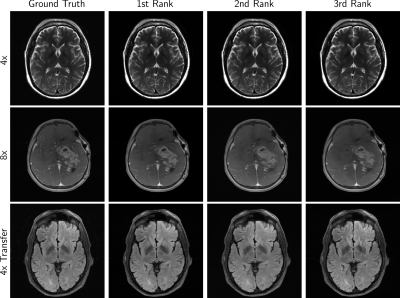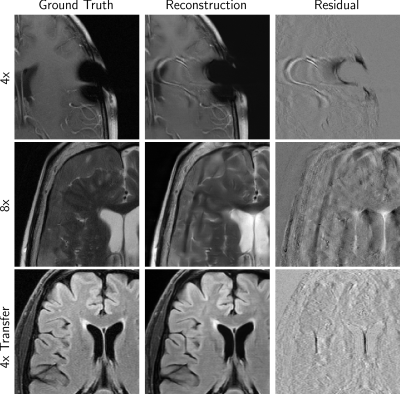Bruno Riemenschneider1, Matthew Muckley2, Alireza Radmanesh1, Sunwoo Kim3, Geunu Jeong3, Jingyu Ko3, Yohan Jun4, Hyungseob Shin4, Dosik Hwang4, Mahmoud Mostapha5, Simon Arberet5, Dominik Nickel6, Zaccharie Ramzi7,8, Philippe Ciuciu7, Jean-Luc Starck7, Jonas Teuwen9, Dimitrios Karkalousos10, Chaoping Zhang10, Anuroop Sriram11, Zhengnan Huang1, Nafissa Yakubova2, Yvonne W. Lui1, and Florian Knoll1
1NYU School of Medicine, New York, NY, United States, 2Facebook AI Research, New York, NY, United States, 3AIRS Medical, Seoul, Korea, Republic of, 4Yonsei University, Seoul, Korea, Republic of, 5Siemens Healthineers, Princeton, NJ, United States, 6Siemens Healthcare GmbH, Erlangen, Germany, 7CEA (NeuroSpin) & Inria Saclay (Parietal), Université Paris-Saclay, Gif-sur-Yvette, France, 8Département d’Astrophysique, CEA-Saclay, Gif-sur-Yvette, France, 9Radboud University Medical Center, Nijmegen, Netherlands, 10Amsterdam UMC, Amsterdam, Netherlands, 11Facebook AI Research, Menlo Park, CA, United States
1NYU School of Medicine, New York, NY, United States, 2Facebook AI Research, New York, NY, United States, 3AIRS Medical, Seoul, Korea, Republic of, 4Yonsei University, Seoul, Korea, Republic of, 5Siemens Healthineers, Princeton, NJ, United States, 6Siemens Healthcare GmbH, Erlangen, Germany, 7CEA (NeuroSpin) & Inria Saclay (Parietal), Université Paris-Saclay, Gif-sur-Yvette, France, 8Département d’Astrophysique, CEA-Saclay, Gif-sur-Yvette, France, 9Radboud University Medical Center, Nijmegen, Netherlands, 10Amsterdam UMC, Amsterdam, Netherlands, 11Facebook AI Research, Menlo Park, CA, United States
The 2020 fastMRI challenge revealed a new state-of-the-art machine learning reconstruction model that achieved the best metrics and ranking in almost all challenge categories. The challenge also clarified areas in need of further research.

Figure 2: Exemplary images (up-down: T2, T1POST, and FLAIR) from all tracks and finalist teams. The submissions were rated for overall appearance, artifacts, sharpness, and CNR. Overall, judged cases included both intra- and extra-axial tumors, strokes, microvascular ischemia, white matter lesions, edema, surgical cavities, as well as postsurgical changes and hardware including craniotomies and ventricular shunts.

Figure 3: Examples of failed reconstructions, i.e., resulting artifacts and hallucinations. In the 4x example, some non-winning submissions introduced vessel-like aliasing artifacts, originating from a susceptibility artifact. A similar aliasing-induced hallucination, resulting in incorrect sulcus depiction, is observed in the Transfer case. The particular shown 8x reconstruction suffered from a severe aliasing and hallucination behavior that renders the reconstruction unusable in more obvious fashion.
